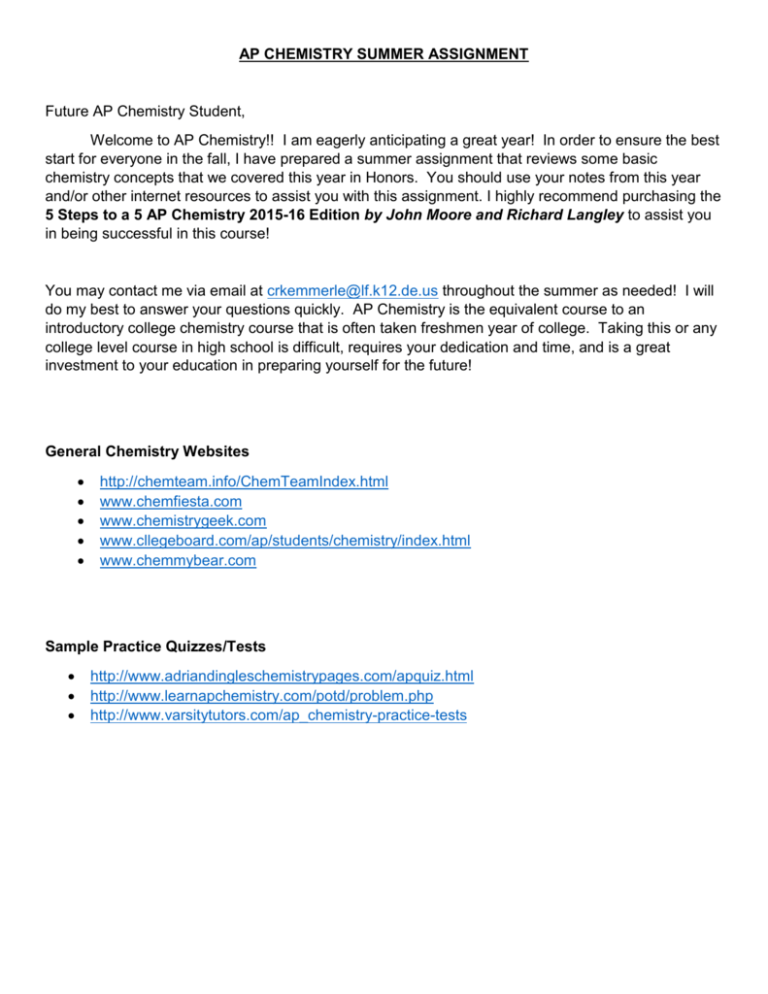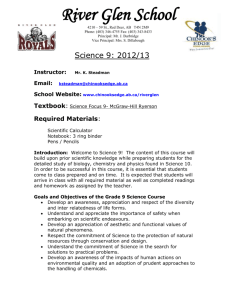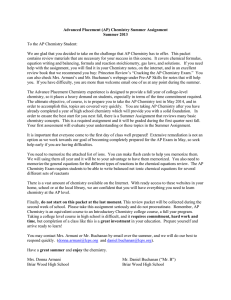AP Chemistry
advertisement

AP CHEMISTRY SUMMER ASSIGNMENT Future AP Chemistry Student, Welcome to AP Chemistry!! I am eagerly anticipating a great year! In order to ensure the best start for everyone in the fall, I have prepared a summer assignment that reviews some basic chemistry concepts that we covered this year in Honors. You should use your notes from this year and/or other internet resources to assist you with this assignment. I highly recommend purchasing the 5 Steps to a 5 AP Chemistry 2015-16 Edition by John Moore and Richard Langley to assist you in being successful in this course! You may contact me via email at crkemmerle@lf.k12.de.us throughout the summer as needed! I will do my best to answer your questions quickly. AP Chemistry is the equivalent course to an introductory college chemistry course that is often taken freshmen year of college. Taking this or any college level course in high school is difficult, requires your dedication and time, and is a great investment to your education in preparing yourself for the future! General Chemistry Websites http://chemteam.info/ChemTeamIndex.html www.chemfiesta.com www.chemistrygeek.com www.cllegeboard.com/ap/students/chemistry/index.html www.chemmybear.com Sample Practice Quizzes/Tests http://www.adriandingleschemistrypages.com/apquiz.html http://www.learnapchemistry.com/potd/problem.php http://www.varsitytutors.com/ap_chemistry-practice-tests ASSIGNMENT!! DUE THE 1ST DAY OF CLASS You will be receiving an AP Chemistry textbook to borrow over the summer. It is expected that you use your previous knowledge from Honors Chemistry as well as read through the first 3 chapters of this book. We will be reviewing some of this together but it will be rather quickly and then very early on next year, you will take your 1st test (covering all 3 chapters). In addition to the assigned questions below, you also need to complete the following questions out of the textbook…ALL ON A SEPARATE SHEET OF PAPER! Work must be shown for all math questions or no credit will be given! BOOK QUESTIONS: Chapter 1 (p. 33-37) 1.2, 1.14, 1.20, 1.30, 1.42, 1.52 Chapter 2 (p. 73-77) 2.1, 2.4, 2.14, 2.24, 2.29, 2.39, 2.56, 2.64, 2.86 Chapter 3 (p. 112-118) 3.2, 3.6, 3.12, 3.20, 3.26 (a only), 3.36, 3.50, 3.54 (b only), 3.64, 3.76 Additional Assigned Questions Directions: These all need to be completed on a separate sheet of paper and you must SHOW ALL WORK, units, and proper significant figures for all problems! 1. What are the general rules for determining significant figures? 2. Use dimensional analysis to convert each of the following: a. 515 m = _____________ miles b. 200 in = _____________ meters c. 325 days = _________________ seconds d. 20 gallons = ________________ mL 3. Convert each of the following: a. 10 km = ________________ m b. 15,050 mg = ________________ g 4. Most laboratory experiments are performed at room temperature at 25 C. Express this temperature in: a. Fahrenheit b. Kelvin 5. How many significant figures are in each of the following? a. 1.92 mm e. 0.000036 cm3 b. 0.030100 kJ f. 100 c. 6.020 x 1023 atoms g. 0.00100 d. 460.00 L 6. Record the following into proper scientific notation: a. 35000000 cal b. 0.0000721 mol c. 0.0000000809 m d. 765400000000 atoms 7. A solid white substance A is heated strongly in the absence of air. It decomposes to form a new white substance B and a gas C. The gas has exactly the same properties as the product obtained when carbon is burned in an excess of oxygen. Based on these observations, can we determine whether solids A and B and the gas C are elements or compounds. Explain your answer for each substance. 8. Label each of the following as either a physical or chemical process. a. Corrosion of aluminum metal f. Milk souring b. Melting of ice g. Burning of paper c. Pulverizing an aspirin h. Forming of frost on a cold night d. Digesting a candy bar i. Copper wire being hammered flat e. Explosion of TNT 9. Calculate the mass of O2 produced if 2.50 g of KClO3 is completed decomposed by heating. 10. Write the formula for each of the following compounds: a. Calcium sulfate b. Potassium perchlorate c. Ammonium phosphate d. Barium oxide e. Lithium nitrite f. Zinc sulfide 11. Convert 3.57 atm to: (use dimensional analysis) a. mm Hg b. pascals 12. Define the following words: atomic number, atomic mass, mass number, molecular formula, structural formula, empirical formula, isotope, cation, anion, and stoichiometry. 13. What is the empirical formula of a compound with 53.73% Fe and 46.27% S? 14. Determine the number of molecules in 2.23 mol of nitrogen gas. 15. Identify the following as diatomic, molecular compound, ionic compound, element: a. F2 f. Ag b. Cl2 g. Fe2O3 c. NaCl h. MgO d. KF i. O2 e. CO2 j. Hg 16. Briefly describe what each of the following scientists do. a. Democritus d. Becquerel b. Mendeleev e. Proust c. Millikan f. JJ Thompson 17. How many grams of oxygen are present in 2.3 moles of oxygen gas? 18. Calculate the mass in grams of each of the following: a. 1.24 x 1024 atoms of Mg b. 3.01 x 1021 formula units of calcium chloride 19. How do you distinguish: a. An element from a compound b. An element from a mixture c. A true solution from a heterogeneous mixture d. Distillation from filtration 20. What mass of copper is required to replace silver from 4.00 g of silver nitrate dissolved in water? Cu + AgNO3 Cu(NO3)2 + Ag 21. Define the law of conservation of mass. 22. An isotope of iodine is Iodine-131. How many…. a. Protons are in its nucleus? c. Electrons are in an iodine atom? b. Neutrons are in its nucleus? d. Electrons are in a -1 iodine ion? 23. Calculate the molar mass of a. Ammonia b. Sodium bicarbonate 24. Convert the following to moles: a. 3.86 g of carbon dioxide b. 6.0 x 105 g of N2H4 25. Calculate the percent composition of each element in the following compounds: a. SO3 b. CH3COOCH3 26. Write the balanced equation for the following: a. Reaction of boron trifluoride gas with water to give liquid hydrogen fluoride and solid boric acid (H3BO3). b. Reaction of magnesium oxide with iron to form iron (III) oxide and magnesium. c. The decomposition of dinitrogen oxide gas to its elements. d. Ethane (C2H6) burns in air. e. Hydrogen reacts with oxygen to form water. f. Nitrogen gas reacts with hydrogen to form ammonia. g. Magnesium and nitrogen gas combine to form magnesium nitride. 27. Define the following: limiting reactant, theoretical yield, and actual yield. 28. Name the five different types of chemical reactions and briefly explain each type. 29. Define solubility and review the solubility rules of ionic compounds (we did not get to this this year…). 30. Name the following: a. CO2 b. P4O10 c. NI3 d. PCl5 e. SF6 f. CH4 g. C2H6 h. CCl4 31. What is the activity series of metals? How does it help us in determining whether or not a reaction will occur? 32. Define the terms endothermic and exothermic. 33. How much heat is required to raise to raise the temperature of 100.0 g of water from 25 C to 82 C? 34. A piece of unknown metal with a mass of 14.9 g is heated to 100 C and dropped into 75.0 g of water at 20 C. The final temperature of the system is 28 C. What is the specific heat of the metal? 35. What is a solute and a solvent? Define molarity, molality, mole fraction, and mass percent. 36. Calculate the molarity of a solution that contains 20.0 g of sodium hydroxide in 200 mL? 37. Nitrogen gas and hydrogen gas combine to produce ammonia, NH3. a. Write the balanced equation for this process. b. How many grams of ammonia can be produced from 154.7 g of nitrogen, N 2? c. How many liters of ammonia would be produced from 35.2 g of hydrogen? 38. Hydrogen fluoride is used to manufacture Freon and in the production of aluminum metal. It is prepared by the following reaction: CaF2 + H2SO4 CaSO4 + 2 HF. In one process 8.51 g of CaF2 is treated with an excess amount of H2SO4 and yields 2.86 g of HF. Calculate the percent yield of HF.







